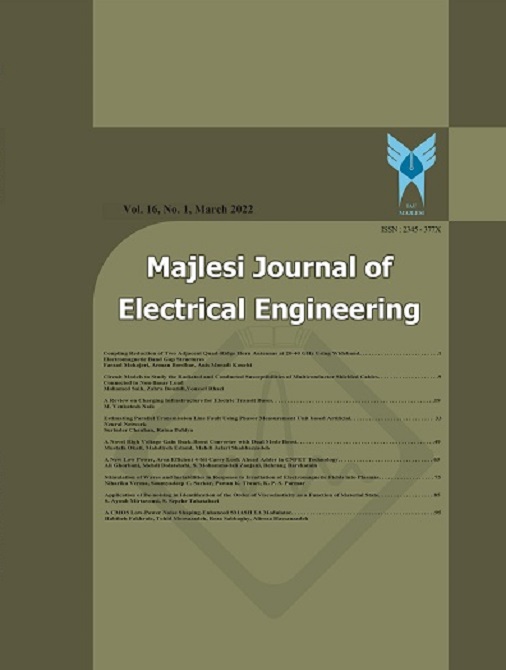[1] Samir Abdelmalek, Hocine Belmili, Linda Barazane, Larabi Abdelkader, “A New Robust H∞ Control Power”, International Conference on Control, Engineering & Information Technology (CEIT’14) Proceedings - Copyright IPCO-2014, pp.123-128 ISSN 2356-5608.
[2] Marouane El azzaoui, Hassane Mahmoudi and Chafik Ed-dahmani, “Backstepping control of a doubly fed inductiongenerator integrated to wind power system”, 2nd International Conference on Electrical and Information Technologies IEEE 2016.
[3] M. Doumi, A.G. Aissaoui, A. Tahour, M. Abid, and K. Tahir, “Nonlinear Backstepping Control of a Double-Fed Induction Generator”, 4th International Conference on Renewable Energy Research and Applications, Palermo, Italy; 2015.
[4] Cristian Busca, Ana-Irina Stan, Tiberiu Stanciu and Daniel Ioan Stroe, “Control of Permanent Magnet Synchronous Generator for Large Wind Turbines”, 2010 IEEE.
[5] Swagat Pati, Swati Samantray, “Decoupled Control of Active and Reactive Power in A DFIG Based Wind Energy Conversion System with Conventional PI Controllers”, ICCPCT, IEEE 2014.
[6] Sebastian Khoete, Yusuke Manabe, Muneaki Kurimoto, Toshihisa Funabashi and Takeyoshi Kato, “Robust H-infinity Control for DFIG to Enhance Transient Stability during Grid Faults”, Proceedings of the World Congress on Engineering and Computer Science 2016 Vol II WCECS 2016, October 19-21, 2016, San Francisco, USA
[7] Wang, Yun; Wu, Qiuwei; Gong, Wenming; Gryning, Mikkel Peter Sidoroff, “H-infinity Robust Current Control for DFIG Based Wind Turbine subject to Grid Voltage Distortions”, Published in: IEEE Transactions on Sustainable Energy, 2016.
[8] G. Djamel Eddine, N. Abdellatif, “Commande Robuste H∞ Optimisee par L’algorithme Genetique Appliquee à La Regulation Automatique d’Excitation des Generateurs Synchrones Puissants (Application sous GUI/MATLAB)”, Revue « Nature & Technologie » janvier 2016.
[9] J. Khedri, M. Chaabane, M. Souissi, “Multivariable H∞Robust Controller for a Permanent Magnet Synchronous Machine (PMSM)”, 2015 International Journal on Computer Science and Engineering (IJCSE).
[10] S.Ozana, M.Pies, “Application of H-infinity Robust Controller on PAC”, VSB-Technical University of Ostrava, FEI. Czech Republic, Octobre 2010.
[11] A. A. Hassan; Yehia S. Mohamed, Ali M. Yousefand A. M. Kassem, “Robust Control Based On H∞ Approach For A Wind Driven Induction Generator Connected To The Utility Grid”, Journal of Engineering Sciences, Assiut University,Vol. 34, No. 3, pp. 779-797, May 2006.
[12] P.Gahinet, P.Apkarian, “Structured H∞ Synthesis in MA TLAB”, Preprints of the 18th IFAC World Congress Milano (Italy) August 28 - September 2, 2011.
[13] Abdul Motin Howlader, Naomitsu Urasaki, Atsushi Yona, Tomonobu Senjyu and Ahmed Yousuf Saber “Design and Implement a Digital H∞ Robust Controller for a MW-Class PMSG-Based Grid-Interactive Wind Energy Conversion System”, Energies 2013, 6, 2084-2109; doi:10.3390/en6042084.
[14] H. Karimi, Davijani, A. Sheikholeslami, H. Livani and M. Karimi-Davijani, “Fuzzy Logic Control of Doubly Fed Induction Generator Wind Turbine”, World Applied Sciences Journal 6 (4): 499-508, 2009, ISSN 1818-4952.
[15] N. Chayaopas, W. Assawin chaichote, “H∞ Fuzzy Integral Power Control for DFIG Wind Energy System”, International Journal of Electrical and Computer Engineering Vol: 11, No:5, 2017.
[16] B.Hamane, M. Benghanem, A.M.Bouzid, A.Belabbes,M.Bouhamida,A.Draou, “Control for Variable Speed Wind Turbine Driving a Doubly Fed Induction Generator using Fuzzy-PI Control”, Elsevier Energy Procedia 18 ( 2012 ) 476 – 485.
[17] Marouane El Azzaoui, “Fuzzy-PI control of a doubly fed induction generator-based wind power system”, International Journal of Automation and Control, 2017.
[18] N. Zerzouri and H. Labar, "Active and Reactive Power Control of a Doubly Fed Induction", International Journal of Power Electronics and Drive System, vol. 5, pp. 244-251, October 2014.
[19] F. Mazouz, S. Belkacem, Y. Harbouche, S, Ouchen And R. Abdessemed “Fuzzy Control of a Wind System Based on the DFIG”, International Conference on Artificial Intelligence in Renewable Energetic Systems 2017.

